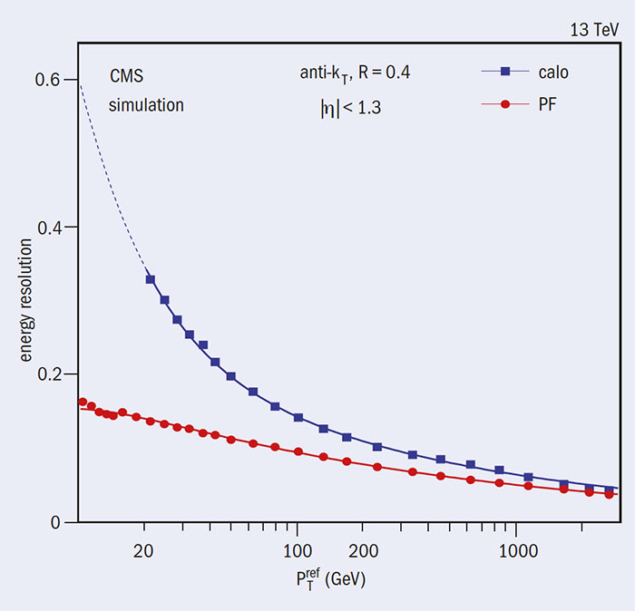Algorithm aims to identify and fully reconstruct particles.

Image credit: CMS Collaboration.
In hadron-collider experiments, jets are traditionally reconstructed by clustering photon and hadron energy deposits in the calorimeters. As the information from the inner tracking system is completely ignored in the reconstruction of jet momentum, the performance of such calorimeter-based reconstruction algorithms is seriously limited. In particular, the energy deposits of all jet particles are clustered together, and the jet energy resolution is driven by the calorimeter resolution for hadrons – typically 100%/√E in CMS – and by the non-linear calorimeter response. Also, because the trajectories of low-energy charged hadrons are bent away from the jet axis in the 3.8 T field of the CMS magnet, their energy deposits in the calorimeters are often not clustered into the jets. Finally, low-energy hadrons may even be invisible if their energies lie below the calorimeter detection thresholds.
In contrast, in lepton-collider experiments, particles are identified individually through their characteristic interaction pattern in all detector layers, which allows the reconstruction of their properties (energy, direction, origin) in an optimal manner, even in highly boosted jets at the TeV scale. This approach was first introduced at LEP with great success, before being adopted as the baseline for the design of future detectors for the ILC, CLIC and the FCC-ee. The same ambitious approach has been adopted by the CMS experiment, for the first time at a hadron collider. For example, the presence of a charged hadron is signalled by a track connected to calorimeter energy deposits. The direction of the particle is indicated by the track before any deviation in the field, and its energy is calculated as a weighted average of the track momentum and the associated calorimeter energy. These particles, which typically carry about 65% of the energy of a jet, are therefore reconstructed with the best possible energy resolution. Calorimeter energy deposits not connected to a track are either identified as a photon or as a neutral hadron. Photons, which represent typically 25% of the jet energy, are reconstructed with the excellent energy resolution of the CMS electromagnetic calorimeter. Consequently, only 10% of the jet energy – the average fraction carried by neutral hadrons – needs to be reconstructed solely using the hadron calorimeter, with its 100%/√E resolution. In addition to these types of particles, the algorithm identifies and reconstructs leptons with improved efficiency and purity, especially in the busy jet environment.

Image credit: CMS Collaboration.
Key ingredients for the success of particle flow are excellent tracking efficiency and purity, the ability to resolve the calorimeter energy deposits of neighbouring particles, and unambiguous matching of charged-particle tracks to calorimeter deposits. The CMS detector, while not designed for this purpose, turned out to be well-suited for particle flow. Charged-particle tracks are reconstructed with efficiency greater than 90% and a rate of false track reconstruction at the per cent level down to a transverse momentum of 500 MeV. Excellent separation of charged hadron and photon energy deposits is provided by the granular electromagnetic calorimeter and large magnetic-field strength. Finally, the two calorimeters are placed inside of the magnet coil, which minimises the probability for a charged particle to generate a shower before reaching the calorimeters, and therefore facilitates the matching between tracks and calorimeter deposits.
After particle flow, the list of reconstructed particles resembles that provided by an event generator. It can be used directly to reconstruct jets and the missing transverse momentum, to identify hadronic tau decays, and to quantify lepton isolation. Figure 1 illustrates, in a given event, the accuracy of the particle reconstruction by comparing the jets of reconstructed particles to the jets of generated particles. Figure 2 further demonstrates the dramatic improvement in jet-energy resolution with respect to the calorimeter-based measurement. In addition, the particle flow improves the jet angular resolution by a factor of three and reduces the systematic uncertainty in the jet energy scale by a factor of two. The influence of particle flow is, however, far from being restricted to jets with, for example, similar improvements for missing transverse-momentum reconstruction and a tau-identification background rate reduced by a factor three. This new approach to reconstruction also paved the way for particle-level pile-up mitigation methods such as the identification and masking of charged hadrons from pile-up before clustering jets or estimating lepton isolation, and the use of machine learning to estimate the contribution of pile-up to the missing transverse momentum.
The algorithm, optimised before the start of LHC Run I in 2009, remains essentially unchanged for Run II, because the reduced bunch spacing of 25 ns could be accommodated by a simple reduction of the time windows for the detector hits. The future CMS upgrades have been planned towards optimal conditions for particle flow (and therefore physics) performance. In the first phase of the upgrade programme, a new pixel layer will reduce the rate of false charged-particle tracks, while the read-out of multiple layers with low noise photodetectors in the hadron calorimeter will improve the neutral hadron measurement that limits the jet-energy resolution. The second phase includes extended tracking allowing for full particle-flow reconstruction in the forward region, and a new high-granularity endcap calorimeter with extended particle-flow capabilities. The future is therefore bright for the CMS particle-flow reconstruction concept.
• CMS Collaboration, “Particle flow and global event description in CMS”, in preparation.





